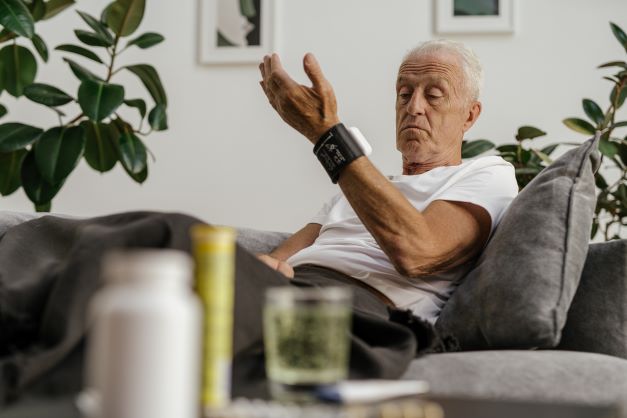Around 15 percent of people aged between 40 and 75 may have a form of undiagnosed high blood pressure (hypertension) that occurs only at nighttime.

Because they do not know about this, and are therefore not being treated for it, they are at a higher risk of cardiovascular disease such as stroke, heart failure and even death, according to new research from the University of Oxford.
The study, published in the British Journal of General Practice, was supported by the NIHR Oxford Biomedical Research Centre (BRC).
It found that when blood pressure is monitored over 24 hours, individuals can be divided into three groups, according to their blood pressure pattern:
- ‘dippers’, for whom nighttime blood pressure is lower than the daytime blood pressure; this is the case for healthy young people
- ‘non-dippers’, for whom nighttime and daytime blood pressure values are not very different
- ‘reverse dippers’, for whom, contrary to expectations, the night-time blood pressure is higher than the day-time blood pressure, when they are up and active.
When undiagnosed and untreated, hypertension, also known as high blood pressure, causes cardiovascular disease, which is one of the main causes of death and disability in the UK. One in eight people in England have undiagnosed hypertension, putting them at risk of cardiovascular disease.
Twenty-four-hour blood-pressure monitoring – usually called ambulatory blood pressure monitoring, or ABPM – has become less frequent in primary care since the beginning of the COVID-19 pandemic. Home blood-pressure monitoring, using a monitor often purchased by individuals themselves, is the common alternative.
However, home blood-pressure monitors cannot be used when the individual is asleep. Therefore, those people whose blood pressure is normal during the day but whose night-time blood pressure rises at night without their knowledge have undiagnosed hypertension, with all the associated risks.
This University of Oxford researchers looked at 24-hour blood pressure patterns in patients admitted to hospital and found that nearly half of these patients have a blood pressure rise at night.
They then looked at blood pressure patterns from patients in primary care from the same age group (40 to 75 years old), who had been monitored for 24 hours during their normal daily activities using ABPM. The proportion of the population in this group who were ‘reverse-dippers’ was around 15 percent.
One possible reason for the difference in the proportion of people found to have a ‘reverse dipping’ blood pressure pattern in the two patient groups is that the community group included a much higher proportion of people who had already been diagnosed with hypertension, and these people are more likely to be ‘dippers’ rather than ‘reverse dippers’. This is because people whose blood pressure is highest in the day and drops at night are more likely to get picked up as having hypertension in GP surgeries and clinics.
Among the key findings of the study were:
- About 15 percent of individuals in the community between the ages of 40 and 75 have a blood pressure rise at night.
- This 24-hour blood pressure pattern is called ‘reverse dipping’, because pressure rises (‘reverse dip’) during the night instead of falling (‘dipping’), the latter being the normal pattern for healthy young people.
- The blood pressure for ‘reverse dippers’ is lowest during the daytime, when they would have their blood pressure checked by their GP and so these people are at risk of having a missed diagnosis of hypertension.
- Conversely, the blood pressure of ‘dippers’ decreases during the night and their blood pressure is highest in the day, so they are more likely to be diagnosed with hypertension.
- There is a well-established body of research which shows that ‘reverse dippers’ are at higher risk of cardiovascular disease such as stroke, heart failure, and even death. The new study found that across all sexes and in both hospital and community patient groups, at least one in three ‘reverse dippers’ had at least one cardiovascular disease.

Co-author Professor Lionel Tarassenko, Director of the Institute of Biomedical Engineering and Oxford BRC Joint Theme lead for Technology and Digital Health, said: “Blood pressure follows a cyclical pattern over 24 hours. Normally, it goes down (or ‘dips’) at night during sleep and then rises after waking. For ‘reverse dippers’ – mostly elderly people, sometimes with diabetes or kidney disease – the pattern is reversed: the blood pressure goes up (or ‘reverse dips’) at night, and then decreases after waking.
“This means that ‘reverse dippers’ have their lowest blood pressure during the day, so they will be falsely reassured by daytime monitoring at home or in the GP clinic. Daytime blood pressure measurements are not enough; it is vitally important to identify who is a reverse dipper through 24-hour ambulatory blood pressure monitoring.”
Commenting on the importance of the new research findings for policymakers and clinicians, co-author Laura Armitage, Doctoral Research Fellow of the Nuffield Department of Primary Care Health Sciences and a practicing GP, said: “The UK NICE Guidelines presently recommend GPs diagnose hypertension based on daytime blood pressure measurements only. However, daytime blood pressure measurements are not capable of detecting high blood pressure in these highest-risk patients whose blood pressure rises at night.
“Our research shows that measuring nighttime blood pressure could help identify the one in eight adults in England who have undiagnosed hypertension. Importantly, this would also lead to a reduction in cardiovascular disease and death. This highlights the need for GPs to offer 24-hour blood-pressure assessment to their patients. This is particularly important for those above the age of 60, as the higher nighttime blood pressure increases with age and blood pressure checks in the surgery and patient self-monitoring at home is not capable of picking up high night-time blood pressure.”